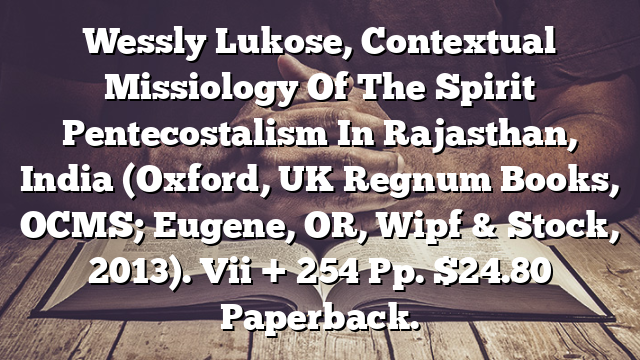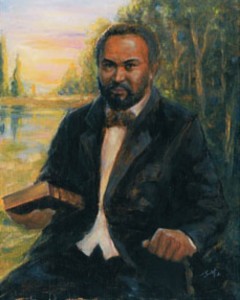Click to join the conversation with over 500,000 Pentecostal believers and scholars
Click to get our FREE MOBILE APP and stay connected
| PentecostalTheology.com



book reviews
483
Wessly Lukose
Contextual Missiology of the Spirit: Pentecostalism in Rajasthan, India(Oxford,
uk: Regnum Books, ocms; Eugene, or, Wipf & Stock, 2013). vii + 254 pp. $24.80
Paperback.
This book is based on Wessly Lukose’s Ph.D. dissertation submitted to the University of Birmingham. Even though the book centres on Pentecostalism in Rajasthan, India, it delves into areas covering wider issues pertaining to global Pentecostalism and Missiology.
Lukose investigates the historical context of Pentecostals in Rajasthan by addressing three central questions: the identity of Pentecostalism in India (Chapter 2), the origin and nature of Pentecostalism in Rajasthan (Chapter 3), and issues facing Pentecostals both within and outside their movement due to misconceptions regarding their origin (Chapters 4 & 5). Emerging from such an investigation, he presents a “contextual missiology of the Spirit” as a new model from a Pentecostal perspective (Chapter 6). He concludes by claiming that his exploration of Pentecostalism in Rajasthan has global implications, indicating the need for further research especially in the arrears of Pentecostal missiology and hermeneutics.
The question of Pentecostal identity is of crucial importance in the Indian context, mainly because of the popular view that Christianity is a foreign commodity brought through Western Colonial manoeuvers and hence has no legitimateplaceintheIndianreligio-culturalmosaic.Lukosemakesagoodcase for the legitimacy of Pentecostal identity in India, particularly in Rajasthan. He investigates the origin of Pentecost in Rajasthan, by first rejecting three popular approaches: one, the Eurocentric approach that views Indian Pentecostalism as an overflow from Azusa Street, the view that the Mukti Mission revival was the Indian Azusa Street, and the approach that claims that “Pentecostal—like Movements” before and after the Mukti revival led to Indian Pentecostalism. He rejects these approaches on the grounds that they are either historically incorrect or based on a restrictive view on what is it to be Pentecostal. To understand how Pentecost began in Rajasthan Lukose employs Anderson’s “many—Jerusalem” theory for the origins of global Pentecostalism.1 Anderson claims that the Global Pentecostal Movement is not the child of Azusa Street only but a product of several indigenous revivals in different parts of the world. Lukose articulates this view meticulously to make the claim that Indian, in
1 Allan Anderson, An Introductory Pentecostalism: Global Charismatic Christianity(Cambridge:
cup, 2004), p. 115.
© koninklijke brill nv, leiden, 2014 | doi: 10.1163/15700747-03602018
1
484
book reviews
particular Rajasthan Pentecostalism originated as a result of several indigenous revivals. His presentation surely meets the rigorous requirements of a Ph.D. thesis of academic quality. But his work would be of greater interest to a wider readership had he developed some of the noteworthy socio-cultural and theological issues that his in-depth study suggests: issues such as what is it that constitutes “being Pentecostal,” on what grounds can one distinguish between “really Pentecostal” and “Pentecostal-like” experiences, between Pentecostal and Charismatic episodes, the uniqueness of Pentecostal “enacted theology,” (10) and how to assess its legitimacy.
Moreover adopting the “many-Jerusalem” theory generates a more funda- mental question concerning the nature of the ministry of the Holy Spirit, espe- cially after the “first Jerusalem” on the day of Pentecost. Could it be that the core reason for preferring the “many-Jerusalem” theory over the “centre-to periph- ery” schema to describe Pentecostal history resides in the way the Holy Spirit functions in the world at large? Just as the 120 believers were filled the Spirit on the Day of Pentecost, the Holy Spirit is very much at work wooing people to “Pentecost” in diverse faith communities of the world. Of course these com- munities need to be first introduced to and accept Christ. But in a community that has accepted Christ, the Holy Spirit is already at work and it is no surprise for the people of such a community to experience “Pentecost.” Perhaps this is what has and is happening in remote villages in India and different parts of the world.
Lukose’s proposal of a “contextual missiology of the Spirit,” based on his meticulous historical research is well articulated (Chapter 6). On the grounds of his perception that Pneumatology has been eclipsed by Christology and Trinitarian approaches to mission studies, he attempts to focus on the mission of the Spirit mainly through the church. He provides ample historical evidence to show that the Holy Spirit is the main reason for the outstanding growth of Pentecostalism throughout the world and India in particular. In attempting to highlight Pneumatology in mission theology, he does not want to reduce the Christological or Trinitarian focus. He is keen to work out his proposal within a Trinitarian framework. On the other hand, such a placement tends to generate a “pneumato-centric missiology” (172).
It is at this juncture that one needs to pause and ponder Lukose’s extensive survey concerning the role of the Spirit in the context of religio-political perse- cution, inter-cultural tension, mission theology and practice, global and local mission, and socio-political issues (176–181). All this is well taken, but does it warrant us to posit a “pneumato-centric missiology”? Lukose suggests that fur- ther research is needed to verify whether his Pneumatological model is a viable alternative to the Christological model in the contemporary Indian context
PNEUMA 36 (2014) 457–512
2
book reviews
485
(210). He seems to think that, the attempt to present the Christian message to India from a Christological position has not been successful. But should Christ and the Holy Spirit be taken as different alternatives? The role of the Spirit has always been to elevate Christ. Those led by the Spirit proclaim Christ as Lord and when he is elevated he draws people to himself, of course with the woo- ing of the Spirit. He enables believers to be effective witnesses for Christ. The Christological and Pneumatological models seem complementary rather than different alternatives.
Lukose’s investigation encourages historians to have a second look at the history of Pentecost and his proposal is a refreshing reminder of Holy Spirit’s unique ministry in the mission field.
Lyman Kulathungam
Dean Emeritus (Intercultural), Master’s College & Seminary Visiting Professor in Philosophy & Religion
lyman.kulathungam@rogers.com
PNEUMA 36 (2014) 457–512
3


